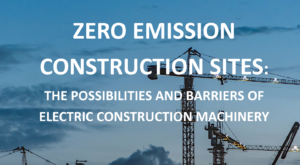Construction is a fundamental component of human civilization. It lies at the heart of economic and social development. The construction industry generates roughly 9% of European GDP and accounts for 18 million jobs. In spite of this, construction sites are also a major source of environmental and human health damage throughout all aspects of the construction process.
While it is well known that construction sites are the source of different forms of pollution – including
material waste, visible dust, noise, and vibration – construction and demolition sites also produce less obvious pollutants which are of serious concern for human health (NOx and particulate matter).
Combined with increasing urbanization trends and a fast-growing global population, it goes without saying that construction is here to stay. This calls for the adoption of timely policies and measures at the local-, national- and EU levels to encourage the transition to zero emission technologies and processes across the full construction supply chain. Bellona reports about these challenges in construction.
Pathways to reduction emissions
A number of different pathways and tools exist to enable efficiency gains and emission cuts from construction site machinery, ranging from:
- engine and machine component improvements;
- process optimization;
- dedicated training of machine operators to reduce fuel use;
- the deployment of alternative technological solutions such as electrification of the
machinery.
Electrification of machinery
The report by Bellona only explores one of these, namely the potential of electrification. The Bellona report takes a closer look into the solutions which exist today, the current policy and market advances in this regard, and goes on to provide some forward-looking policy recommendations, drawing on EU legislation that is undergoing reform, and pending transposition at national levels.
Infrastructure
Similarly to electric vehicles on the road, the electrification of construction site machinery necessitates investments into the deployment of suitably positioned charging infrastructure. The Energy Performance of Buildings Directive offers synergies since it mandates the pre-equipping of new and renovated buildings with pre-tubing for EV charge points. The use of electric construction machinery supports the compliance of this directive in ensuring the installation of charging facilities during the construction process. All charging infrastructure installed should be capable of modulating the charging process in reaction to price and grid signals.
Public procurement
Government expenditure on works, goods, and services represent around 14% of EU GDP, accounting for roughly €1.8 trillion annually. This makes cities powerful actors in boosting demand for sustainable zero-emission construction sites while building trust among consumers and creating certainty for the industry to invest in low- and zero-emission products and processes.
Read the full report here.

